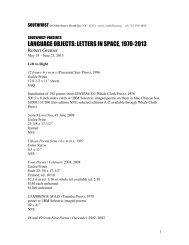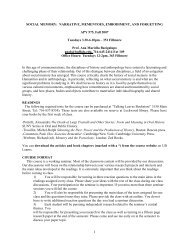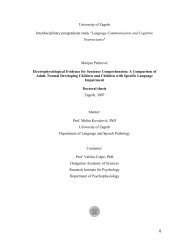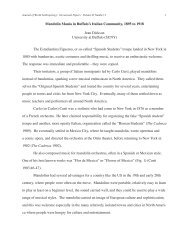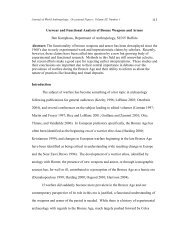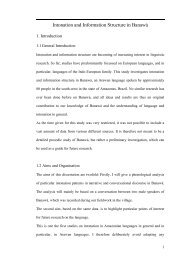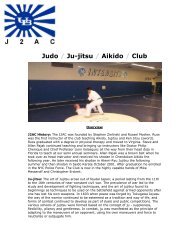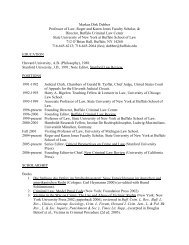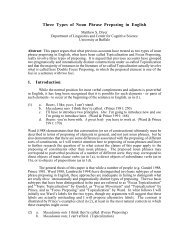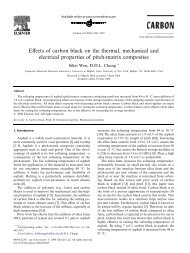1 1 Intrasite Spatial Analysis of a Late Upper Paleolithic ... - Wings
1 1 Intrasite Spatial Analysis of a Late Upper Paleolithic ... - Wings
1 1 Intrasite Spatial Analysis of a Late Upper Paleolithic ... - Wings
Create successful ePaper yourself
Turn your PDF publications into a flip-book with our unique Google optimized e-Paper software.
Journal <strong>of</strong> World Anthropology: Occasional Papers: Volume III, Number 1 1<br />
<strong>Intrasite</strong> <strong>Spatial</strong> <strong>Analysis</strong> <strong>of</strong> a <strong>Late</strong> <strong>Upper</strong> <strong>Paleolithic</strong> French Site Using Geographic<br />
Information Systems<br />
Introduction<br />
by Dustin Keeler<br />
This paper is an analysis <strong>of</strong> site structure as it applies to social and behavioral<br />
organization within <strong>Paleolithic</strong> hunter-gather camp sites. A complete understanding <strong>of</strong><br />
site structure requires the examination <strong>of</strong> high-definition sites that are very well preserved<br />
in terms <strong>of</strong> their spatial integrity. Magdalenian open-air sites within the Paris basin are<br />
some <strong>of</strong> best-preserved <strong>Paleolithic</strong> sites, due to particular depositional processes present<br />
at the sites, the light flooding <strong>of</strong> nearby rivers and gentle accumulation <strong>of</strong> silts and sand.<br />
The spatial structures <strong>of</strong> Magdalenian sites within the Paris basin are comparable to the<br />
spatial structures <strong>of</strong> many other <strong>Paleolithic</strong> sites and certain types <strong>of</strong> ethnographic hunter-<br />
gatherer sites. Verberie is one <strong>of</strong> the best examples <strong>of</strong> a high-definition site within the<br />
Paris Basin and therefore well suited for a spatial examination <strong>of</strong> site structure.<br />
It has long been known that these sites were optimal resources for spatial analysis<br />
but there has always been the problem <strong>of</strong> choosing the most effective techniques in<br />
performing the spatial analysis. New techniques are continuously being developed, each<br />
<strong>of</strong> which add to the ability <strong>of</strong> accurately analyzing spatial data, but the most important<br />
advance in the recent past has been the development <strong>of</strong> new tools that can be used in<br />
spatial analysis. Geographic Information Systems are particularly well suited for the<br />
spatial analysis <strong>of</strong> <strong>Paleolithic</strong> sites since they are able to quickly and easily store and<br />
work with the large amount <strong>of</strong> spatial data that results from the excavations <strong>of</strong> <strong>Paleolithic</strong><br />
1
Journal <strong>of</strong> World Anthropology: Occasional Papers: Volume III, Number 1 2<br />
sites 1 . New techniques <strong>of</strong> spatial analysis available through Geographic Information<br />
Systems allow for a much better understanding <strong>of</strong> spatial relationships then was<br />
previously possible.<br />
Once the spatial data from these sites is analyzed another problem arises <strong>of</strong> how<br />
best to interpret the results. The results may be interpreted based on a variety <strong>of</strong><br />
assumptions about the processes that produced the spatial pattern. A particular model <strong>of</strong><br />
site structure may also order an interpretation <strong>of</strong> spatial data from hunter-gatherer sites.<br />
Finally, the assumptions made about <strong>Paleolithic</strong> hunter-gatherer camp sites as well the<br />
site structure models applied to them have changed dramatically over the past thirty years<br />
due to more and more advanced archaeological research and the incorporation <strong>of</strong><br />
ethnoarchaeological observations.<br />
The analysis that I will perform on the data from Verberie will utilize some <strong>of</strong> the<br />
most advanced techniques <strong>of</strong> spatial analysis available in Geographic Information<br />
Systems. The results <strong>of</strong> this analysis will then be interpreted using the most current<br />
models and assumptions <strong>of</strong> <strong>Paleolithic</strong> site structure in order to better understand<br />
Magdalenian behavioral and social organization at the site <strong>of</strong> Verberie.<br />
1 The spatial data from most <strong>Paleolithic</strong> excavations is very detailed since in many cases the exact location<br />
<strong>of</strong> every artifact is recorded and the number <strong>of</strong> artifacts found at just one <strong>Paleolithic</strong> site can be in the 100’s<br />
<strong>of</strong> thousands.<br />
2
Journal <strong>of</strong> World Anthropology: Occasional Papers: Volume III, Number 1 3<br />
Figure 1. Verberie site map: Level II.1 .<br />
Site<br />
Verberie is a critically important site in that its unique qualities lend themselves to<br />
a high quality analysis. Among these unique qualities is the amount <strong>of</strong> unusually well<br />
preserved faunal remains at the site, the very clear spatial organization resulting from<br />
short seasonal occupations, the unpatinated lithics at the site that allow for a high quality<br />
microwear analysis, and simply the large variety <strong>of</strong> activities that were performed at the<br />
site, <strong>of</strong> which we are well informed due to the other unique qualities. The presence <strong>of</strong> all<br />
part <strong>of</strong> the reindeer is also unique for this type <strong>of</strong> site and implies the primary butchering<br />
took place there and that the settlement was very close to the kill location. This is unique<br />
since most other sites present a selection <strong>of</strong> parts related to transportation from kill sites<br />
further away.<br />
3
Journal <strong>of</strong> World Anthropology: Occasional Papers: Volume III, Number 1 4<br />
Verberie is a stratified open air site located at the bottom <strong>of</strong> the Oise river valley.<br />
It was regularly covered by silts brought by floods. This resulted in the unusually good<br />
preservation <strong>of</strong> eight successive and highly spatially organized living floors with bones,<br />
flint, and hearths, making it is possible to identify activity areas such as flint workshops,<br />
butchering areas, and filleting areas, and <strong>of</strong>fering great promise for the interpretation <strong>of</strong><br />
past human behavior. The living floors belong to the late Magdalenian, which is dated<br />
during the most temperate phase <strong>of</strong> Bolling (13000-12500 BP) between two cold phases<br />
<strong>of</strong> the Dryas. It’s lithic and bone industry is typical <strong>of</strong> the period. Verberie has been<br />
excavated for twenty-six years since the late 70’s. Over the course <strong>of</strong> the excavation eight<br />
occupation levels have been identified. The data from one level, level II.1, has been the<br />
most extensively analyzed. The analysis <strong>of</strong> data from this layer includes lithic use-wear<br />
studies and refitting <strong>of</strong> both flint and bone. Both <strong>of</strong> these analyses have contributed to the<br />
interpretation <strong>of</strong> the spatial structure <strong>of</strong> the site, but no formal spatial analysis had as yet<br />
been performed on any <strong>of</strong> the data. The spatial interpretations have so far come just from<br />
visual inspection <strong>of</strong> the artifact distribution displayed on site maps.<br />
One problem with Verberie is that it is difficult to distinguish between the several<br />
occupation layers, which are located directly on top <strong>of</strong> each other. Vertical spatial<br />
analysis techniques are used to understand the deposits in sites such as this (Koetje,<br />
1991). Some statistical methods <strong>of</strong> this type have been used Verberie and we can be<br />
reasonably sure <strong>of</strong> layer distinctions at this point (Audouze and Enloe, 1997).<br />
The first interpretation <strong>of</strong> spatial patterning at Verberie was based on the<br />
interpretation <strong>of</strong> Pincevent by Leroi-Gourhan. The interpretation was that <strong>of</strong> hearths<br />
within tents (Gamble, 1986). A latter interpretation <strong>of</strong> the spatial patterning was<br />
4
Journal <strong>of</strong> World Anthropology: Occasional Papers: Volume III, Number 1 5<br />
influenced by the work <strong>of</strong> Binford among the Nuniamut. In it the location <strong>of</strong> the tents<br />
were moved back farther away from the hearths to the empty areas near the hearths with<br />
the area directly around the hearth being interpreted as a drop zone (Audouze, 1988). The<br />
interpretation <strong>of</strong> areas not associated with the hearths was also influenced by the work <strong>of</strong><br />
Binford (Audouze and Enloe, 1997). These areas located at the peripheries <strong>of</strong> artifact<br />
concentrations adjacent to the hearth were interpreted as areas <strong>of</strong> butchery since they<br />
were largely devoid <strong>of</strong> artifacts but surrounded by rejected bone. Use-wear analysis <strong>of</strong><br />
blades found within these areas identified them as having been used to cut meat<br />
(Audouze and Enloe, 1997). This fit with Binford’s model <strong>of</strong> the area <strong>of</strong> butchery that he<br />
observed among the Nuniamut (Audouze, 1988; Enloe, 2002).<br />
Use-wear studies by Keeley and Symens involving the examination <strong>of</strong> the traces<br />
and polished wear on lithics under the microscope led to the determination <strong>of</strong> what<br />
activities were performed at the site and where they were performed (Audouze, 1994;<br />
Keeley, 1991; Symens, 1986). This was also used to interpret use and discard patterns in<br />
relation to the spatial distribution <strong>of</strong> artifacts (Symens, 19860. The main activities<br />
identified through use-wear analysis were the cutting <strong>of</strong> meat, bone working, and skin<br />
working. Data on the use <strong>of</strong> stone tools was used in the interpretation <strong>of</strong> spatial patterning<br />
through the identification <strong>of</strong> activity areas. In some cases it confirmed the previous<br />
interpretation <strong>of</strong> the spatial structure in that the areas thought to be locations <strong>of</strong> butchery<br />
contained tools with use wear caused by meat cutting (Enloe, 2002). In other cases they<br />
produced new insights into the location <strong>of</strong> activities such as bone and antler working,<br />
which was mainly performed around the hearth (Keeley, 1991:263-266), and even<br />
demonstrated some resharpening done by unskilled knappers, possibly children. A<br />
5
Journal <strong>of</strong> World Anthropology: Occasional Papers: Volume III, Number 1 6<br />
problem with the use <strong>of</strong> use-wear studies in the interpretation <strong>of</strong> spatial patterning is<br />
factors such discard <strong>of</strong> tools and the cleanup <strong>of</strong> sites (Keeley, 1991:258). An analysis that<br />
can determine the affects <strong>of</strong> these factors is the refitting studies.<br />
The results <strong>of</strong> the lithic refitting studies have mainly been used to identify the<br />
various stratigraphic layers <strong>of</strong> the site, which are directly on top <strong>of</strong> each other, making<br />
them hard to distinguish, but they have also been used in the identification <strong>of</strong> flint<br />
knapping activity areas at the site that are mainly located around the hearths (Audouze<br />
and Enloe, 1997). It is also possible to distinguish trough the refitting <strong>of</strong> flint blocks<br />
between very good knappers, regular ones, and unskilled ones, the later corresponding to<br />
children who have not yet mastered motor habits. A more complete lithic refitting study<br />
is currently being done for all the layer <strong>of</strong> the site. Jim Enloe has done a refitting study <strong>of</strong><br />
the faunal material, which has implications on the interpretation <strong>of</strong> social organization at<br />
Verberie, in that it may indicate food sharing and communal eating among the occupants<br />
<strong>of</strong> the site (2002). There are different patterns <strong>of</strong> faunal refitting in sites in the Paris<br />
Basin. In some sites such as Pincevent the refits are mostly between households while at<br />
Verberie, the refits are between a central area to the households. This may indicate<br />
different patterns <strong>of</strong> food sharing, food sharing within nuclear or extended families at<br />
Pincevent and more communal food sharing at Verberie. One <strong>of</strong> the major questions<br />
concerning Verberie is weather it was occupied by a task group <strong>of</strong> hunters or one or more<br />
families (Enloe, 2002). The spatial structure <strong>of</strong> the site is largely dependant on which <strong>of</strong><br />
these types <strong>of</strong> groups inhabited the site therefore the spatial analysis will be used to<br />
answer this question. Since the social conditions existing at the site will play a major role<br />
in our proposed study we will include these results in our spatial analysis.<br />
6
Journal <strong>of</strong> World Anthropology: Occasional Papers: Volume III, Number 1 7<br />
Data<br />
The data used in this spatial analysis <strong>of</strong> occupation floors comes from level II.1 <strong>of</strong><br />
Verberie. This is the first level excavated at the site from the late 70’s into the 80’s. The<br />
exact locations <strong>of</strong> every single artifact found were recorded during excavation. Additional<br />
attribute data includes information on the artifacts, including form, size, and use-wear.<br />
The data available is in a variety <strong>of</strong> forms. The pure locational data for all <strong>of</strong> the<br />
artifacts made up one tables that included over 26,000 entries. It includes all the tools as<br />
well as non-tool data such as bone and stone and all the flakes <strong>of</strong> all materials. Another<br />
table consisted <strong>of</strong> tool locations and their attributes, consisting <strong>of</strong> the coordinate data, the<br />
type <strong>of</strong> tool, the material <strong>of</strong> the lithic, the function <strong>of</strong> the tool, and the material it was<br />
used on (from use-wear studies). The third table was in the form <strong>of</strong> quadrats, consisting<br />
<strong>of</strong> artifact counts within a 10cm grid. The information provided by this data set is from<br />
the area around the south hearth, excluding the main dump.<br />
<strong>Analysis</strong><br />
For a site like Verberie multiple levels <strong>of</strong> analysis are required, ranging from<br />
fairly global to very fine-grained. The first step <strong>of</strong> the spatial analysis will be the<br />
identification <strong>of</strong> spatial clusters at multiple levels <strong>of</strong> resolution. This study will use kernel<br />
density estimation as an analytical technique that has the ability to emphasize either local<br />
structure or overall patterns.<br />
More specifically Kernel density estimation is a method by which the smoothed<br />
value at any point is estimated. The estimated value is calculated by using a weighted<br />
7
Journal <strong>of</strong> World Anthropology: Occasional Papers: Volume III, Number 1 8<br />
average based on the values <strong>of</strong> all other points. The kernel is a probability function that<br />
calculates the weights at each point. The bandwidth is the width <strong>of</strong> the area from which<br />
the points are taken to calculate the estimated weight at the each point. This is more or<br />
less the equivalent <strong>of</strong> the “bin” width in a histogram. Changing the value <strong>of</strong> the<br />
bandwidth, which can be set to reflect different scales <strong>of</strong> interest, can control the degree<br />
<strong>of</strong> smoothing. The result is spatially smooth estimate <strong>of</strong> the intensity <strong>of</strong> events over a<br />
study area (Bailey, 1994:27).<br />
Kernel density estimates are preferable to other spatial cluster analysis for they<br />
reveals pattern more clearly, produces smoother surfaces and allows tuning <strong>of</strong> the density<br />
through changing the bandwidth (Wheatley and Gillings, 2002:186). It can be used to<br />
examine structure at different levels <strong>of</strong> resolution and this study will be concerned with<br />
identifying the highly local surface that reflects smaller clusters <strong>of</strong> points equating to the<br />
activity areas as well as broader surfaces that reflect larger clusters representing social<br />
units. The specific merits <strong>of</strong> kernel density estimates are that they represent the real<br />
structure <strong>of</strong> clusters through contouring, rather that the spherical clusters produced by k-<br />
means cluster analysis. They can aide in the determination <strong>of</strong> the number <strong>of</strong> clusters<br />
through the examination <strong>of</strong> contours at different levels <strong>of</strong> inclusion as a means <strong>of</strong> looking<br />
for structure at different scales <strong>of</strong> spatial resolution (Baxter, Beardah, and Wright, 1997).<br />
An application <strong>of</strong> kernel density estimates by Baxter, Beardah, and Wright on the data<br />
from the Mask site studied by Binford showed that this type <strong>of</strong> analysis identifies<br />
structure in the distribution <strong>of</strong> materials more clearly than other methods (1997).<br />
Kernel density estimates will be performed on individual areas <strong>of</strong> the surface to<br />
identify higher resolutions <strong>of</strong> the clustering in areas that are underrepresented when<br />
8
Journal <strong>of</strong> World Anthropology: Occasional Papers: Volume III, Number 1 9<br />
looking at the entire surface, which is dominated by the dump and hearth locations. The<br />
results that will be obtained through kernel density analysis will be compared to the<br />
results <strong>of</strong> other analysis that will be performed on the same data such as unconstrained<br />
clustering. Preliminary use <strong>of</strong> kernel density estimate analysis <strong>of</strong> the data from level II.1<br />
has shown that clusters defined by this method are more representative <strong>of</strong> the actual<br />
spatial distribution than other methods <strong>of</strong> cluster analysis.<br />
Whallon’s unconstrained clustering is a well known approach that is a framework<br />
for analysis rather than a sequence <strong>of</strong> rigid methods. The approach consists <strong>of</strong> creating<br />
smoothed density contours over an area from the distribution patterns <strong>of</strong> separate artifact<br />
types. The density <strong>of</strong> each type is then determined at each data point from the smoothed<br />
density contours. The vector <strong>of</strong> densities is then converted to a vector <strong>of</strong> relative densities<br />
by summing the elements <strong>of</strong> the vector and dividing each <strong>of</strong> the elements by the sum for<br />
that vector. Cluster analysis is then performed to combine data points into groups that<br />
tend to be homogeneous with respect to the vectors <strong>of</strong> relative densities. Finally, one<br />
plots the data points belonging to each group on the floor and inspecting them for spatial<br />
integrity or interpretable spatial patterning. This description is informative <strong>of</strong> the<br />
structure and patterning inherent in the data and can be informative <strong>of</strong> the processes and<br />
activities that formed the observed spatial distributions (Whallon, 1984).<br />
The analysis using GIS began using the quadrat data for the area around the south<br />
hearth to create nearest neighbor smooth contour maps for each <strong>of</strong> the major artifact<br />
classes. Those include flint, bone, rock, esquille flint, esquille bone, and esquille rock.<br />
The esquille artifacts are those artifacts under 1 cm in size. They are distinguished from<br />
the larger artifacts because they are much more likely to have been subject to<br />
9
Journal <strong>of</strong> World Anthropology: Occasional Papers: Volume III, Number 1 10<br />
bioturbation, which consisted mainly <strong>of</strong> movement by worms. They are also put into<br />
separate classes because they can identify locations where specific activities were<br />
performed more than larger artifacts, which were more likely to have moved by the<br />
occupants <strong>of</strong> the site.<br />
The density map <strong>of</strong> the flint (figure 2) shows a very high concentration around the<br />
hearth. The flint in this area is much more widely distributed than this map actually<br />
displays, but the areas away from the hearth are underrepresented because the density <strong>of</strong><br />
artifacts around the hearth is so much higher relative to the densities away from the<br />
hearth. That is one <strong>of</strong> the problems with density maps <strong>of</strong> this type, if the density is too<br />
high in one area other areas may be underrepresented. Nonetheless, this map is useful in<br />
displaying the clusters around the hearth, the importance <strong>of</strong> which will be discussed in<br />
the interpretation section.<br />
Figure 2. Density map <strong>of</strong> flint around hearth 1.<br />
10
Journal <strong>of</strong> World Anthropology: Occasional Papers: Volume III, Number 1 11<br />
The density map for the bone around hearth 1 (figure 3) more accurately displays<br />
the widespread distribution <strong>of</strong> the artifact type throughout the entire are. It not only<br />
shows a high concentration around the hearth but also in adjacent areas each <strong>of</strong> which is<br />
accurately represented because no one density cluster is too high relative to the other<br />
clusters.<br />
Figure 3. Density map <strong>of</strong> bone around hearth 1.<br />
The density map <strong>of</strong> esquille flint (figure 4) looks much the same as the density<br />
map <strong>of</strong> flint. The difference is that the esquille flint density map actually does accurately<br />
11
Journal <strong>of</strong> World Anthropology: Occasional Papers: Volume III, Number 1 12<br />
represent the distribution <strong>of</strong> the artifact within the area. Esquille flint is highly<br />
concentrated around the hearth and is not found in any significant amount further away<br />
from it.<br />
Figure 4. Density map <strong>of</strong> esquille flint around hearth 1.<br />
The density map <strong>of</strong> esquille bone (figure 5) is also an accurate representation <strong>of</strong><br />
the distribution <strong>of</strong> the artifact type but it displays a very different distribution than that <strong>of</strong><br />
the bone. This is important for the interpretation <strong>of</strong> activity locations and will be further<br />
discussed in the next section.<br />
12
Journal <strong>of</strong> World Anthropology: Occasional Papers: Volume III, Number 1 13<br />
Figure 5. Density map <strong>of</strong> esquille bone around hearth 1.<br />
For the next step <strong>of</strong> the analysis I performed unconstrained cluster analysis using<br />
the quadrat data for the area around the first hearth. I used a method similar to Whallon’s,<br />
only I used the relative densities <strong>of</strong> the three major artifact classes, rock, flint and bone,<br />
within one meter squares. I performed a cluster analysis on these squares using a<br />
hierarchical clustering method within the SPSS statistical program which grouped the<br />
squares into classes based on the relative density <strong>of</strong> artifact types within them. The results<br />
<strong>of</strong> this analysis can be displayed graphically by numbering the squares based on their<br />
designated class (figure 6).<br />
13
Journal <strong>of</strong> World Anthropology: Occasional Papers: Volume III, Number 1 14<br />
Figure 6. Unconstrained clustering around hearth 1.<br />
Table 1. Cluster descriptions<br />
cluster 1- low percentage <strong>of</strong> rock, higher percentage <strong>of</strong> flint, and a very high<br />
percentage <strong>of</strong> bone<br />
cluster 2- low percentages <strong>of</strong> rock and flint, high percentage <strong>of</strong> bone<br />
cluster 3- very low percentage <strong>of</strong> rock, higher percentage <strong>of</strong> flint, very high<br />
percentage <strong>of</strong> bone<br />
cluster 4- very low percentages <strong>of</strong> rock and flint, very high percentage <strong>of</strong> bone<br />
cluster 5- low percentage <strong>of</strong> flint, higher percentage <strong>of</strong> rock, very high percentage <strong>of</strong><br />
bone<br />
cluster 6- low percentage <strong>of</strong> rock, even percentages <strong>of</strong> flint and bone<br />
cluster 7- similar percentages for all three types<br />
cluster 8- low percentage <strong>of</strong> rock and bone, high percentage <strong>of</strong> flint<br />
cluster 9- very low percentage <strong>of</strong> Rock and bone, very high percentage flint<br />
cluster 10-very low percentage <strong>of</strong> rock, higher percentage <strong>of</strong> bone, very high<br />
percentage <strong>of</strong> flint<br />
14
Journal <strong>of</strong> World Anthropology: Occasional Papers: Volume III, Number 1 15<br />
This unconstrained clustering analysis achieved the purpose that was originally<br />
intended by Whallon, that is the identification <strong>of</strong> clusters that are not spatially constrained<br />
and that are not dependant on the absolute density <strong>of</strong> artifacts, as pure locational clusters<br />
are (Whallon, 1984). The unconstrained clustering can be used to make inferences about<br />
the relationship between various classes <strong>of</strong> artifacts and can identify similarities between<br />
unconnected areas within a site. It may also be used in comparison with the density maps<br />
to further define the locational clusters.<br />
The next step <strong>of</strong> the analysis involved the creation <strong>of</strong> kernel density estimates<br />
using the point artifact location data for all the material in level II.1. I experimented by<br />
using different bandwidths to determine which would most accurately display the artifact<br />
cluster. Because <strong>of</strong> the large amount <strong>of</strong> artifacts, over 26,000, it was necessary to use a<br />
very small bandwidth. Kernel density maps were created for all artifact classes combined<br />
as well as the individual artifact classes. The kernel density maps more accurately display<br />
the variation <strong>of</strong> densities within the clusters while the kernel density contour maps more<br />
accurately display the boundaries <strong>of</strong> clusters.<br />
The results <strong>of</strong> this pure locational clustering technique are more useful compared<br />
to results that could be achieved using other techniques such as K-means clustering. Like<br />
K-means clustering, kernel density estimates can identify clusters at multiple levels <strong>of</strong><br />
resolution 2 but kernel density estimates do not require the number <strong>of</strong> clusters to be<br />
determined before hand as K-means clustering does. For this reason the number <strong>of</strong><br />
2 Only the kernel density estimates <strong>of</strong> the optimal resolution are displayed here. The optimal resolution was<br />
decided on based on experimentation through the creation <strong>of</strong> maps at multiple levels <strong>of</strong> resolution. The<br />
optimal resolution chosen was the one that most accurately displayed the size <strong>of</strong> clusters previously<br />
identified though examination <strong>of</strong> the site map.<br />
15
Journal <strong>of</strong> World Anthropology: Occasional Papers: Volume III, Number 1 16<br />
clusters identified using kernel density estimates is probably much closer to the number<br />
<strong>of</strong> actual clusters.<br />
Figure 7. Kernel density map <strong>of</strong> all artifacts in level II.1.<br />
The kernel density map <strong>of</strong> all the artifacts (figure 7) does not accurately show the<br />
extent <strong>of</strong> the distribution since certain areas have such a high density and cause other<br />
areas to be underrepresented. More accurate displays <strong>of</strong> the distribution however will be<br />
seen with the kernel density maps <strong>of</strong> the individual artifact classes. The kernel density<br />
contour map (figure 8) accurately displays the main clusters, which will be discussed in<br />
the interpretation section.<br />
16
Journal <strong>of</strong> World Anthropology: Occasional Papers: Volume III, Number 1 17<br />
Figure 8. Contours <strong>of</strong> kernel density estimates for all artifacts in level II.1.<br />
Figure 9. Kernel density map <strong>of</strong> all bone in level II.1.<br />
17
Journal <strong>of</strong> World Anthropology: Occasional Papers: Volume III, Number 1 18<br />
The kernel density map <strong>of</strong> bone (figure 9) best displays the true extent <strong>of</strong> the<br />
distribution <strong>of</strong> artifacts since the densities <strong>of</strong> bone do not vary to such a large extent over<br />
the occupation area and because bone appears in relatively high densities where other<br />
artifact types do not. The main clusters also appear in the kernel contour map (figure 10)<br />
though the delimitation between them is harder to distinguish.<br />
Figure 10. Contours <strong>of</strong> kernel density estimates for all bone in level II.1.<br />
The kernel density map <strong>of</strong> rock (figure 11) shows that this artifact class only<br />
appears in a significant amount in a few discreet locations. This map is used to identify<br />
18
Journal <strong>of</strong> World Anthropology: Occasional Papers: Volume III, Number 1 19<br />
the exact locations <strong>of</strong> the hearths, which are not displayed in by symbols in this map<br />
since two <strong>of</strong> the cluster locations more accurately show where they are.<br />
The rock kernel contour map (figure 12) displays the least number <strong>of</strong> main<br />
clusters <strong>of</strong> all the artifact types, but the shapes <strong>of</strong> the main clusters that are displayed are<br />
different than those displayed in the maps <strong>of</strong> other artifact classes. This is important for<br />
the interpretation and will be further discussed later.<br />
Figure11. Kernel density map <strong>of</strong> all rock in level II.1.<br />
19
Journal <strong>of</strong> World Anthropology: Occasional Papers: Volume III, Number 1 20<br />
Figure 12. Contours <strong>of</strong> kernel density estimates for all rock in level II.1.<br />
Figure 13. Kernel density map <strong>of</strong> all flint in level II.1.<br />
20
Journal <strong>of</strong> World Anthropology: Occasional Papers: Volume III, Number 1 21<br />
The kernel density map <strong>of</strong> flint (figure13) is very similar to maps <strong>of</strong> all artifacts<br />
and rock since it is less widely distributed than bone and the densities in the main clusters<br />
are much higher than in other areas. The kernel contour map (figure 14) again displays<br />
the main clusters which are similar in shape to contours <strong>of</strong> all artifacts since flint is by far<br />
the most numerous artifact.<br />
Figure 14. Contours <strong>of</strong> kernel density estimates for all flint in level II.1.<br />
The advantage <strong>of</strong> using kernel density estimates over other techniques is<br />
demonstrated in the results obtained in this analysis. The shape <strong>of</strong> the clusters identified<br />
through this method more accurately displays the actual shape <strong>of</strong> the clusters which are<br />
displayed as simple circles in K-means cluster analysis. The level <strong>of</strong> resolution that can<br />
be obtained is probably the greatest advantage <strong>of</strong> this technique. This is best<br />
21
Journal <strong>of</strong> World Anthropology: Occasional Papers: Volume III, Number 1 22<br />
demonstrated by the highly localized maps <strong>of</strong> the area around the south hearth, which<br />
show very clear clusters as well as the variation in densities within the clusters.<br />
The final step <strong>of</strong> the analysis within GIS involved the creation <strong>of</strong> kernel density<br />
maps for each <strong>of</strong> tool types. Only the most significant tool types are displayed. These<br />
distributions are primarily useful in determining activity area and discard patterns.<br />
Although the same technique <strong>of</strong> kernel density estimates is used, the data used to obtain<br />
these results varies significantly in that the number <strong>of</strong> tools is considerably less than the<br />
number <strong>of</strong> artifacts within the classes displayed in the above results. In consequence the<br />
results <strong>of</strong> the kernel density estimates for the tools types vary significantly from the<br />
kernel density estimates for the material classes. Firstly, the bandwidth used to obtain<br />
these results needed to be much higher since there were far fewer data points. Secondly,<br />
the delimitation <strong>of</strong> the clusters identified in these results are less clearly defined. Finally<br />
and related to this last point, there is much less variation within the clusters displayed in<br />
these results.<br />
Burins are one <strong>of</strong> the most important tools types since they are one <strong>of</strong> the most<br />
numerous tools found at the site and were used in one <strong>of</strong> the primary activities performed<br />
at the site. The kernel density map <strong>of</strong> the burins (Figure 15) displays the concentration <strong>of</strong><br />
this tool type in a few locations. The importance <strong>of</strong> this distribution will be discussed in<br />
the following section. The burin spalls, or chutes de burin as they are called in French,<br />
are the byproducts <strong>of</strong> burin manufacture. It is not surprising then that the distribution <strong>of</strong><br />
burin spalls (Figure 16) is similar to that <strong>of</strong> the burins. The relationship between these<br />
distributions will be discussed further in the nest section.<br />
22
Journal <strong>of</strong> World Anthropology: Occasional Papers: Volume III, Number 1 23<br />
Figure 15. Kernel density map <strong>of</strong> burins.<br />
Figure 16. Kernel density map <strong>of</strong> chutes de burins.<br />
Just as the burin distribution does, the distribution <strong>of</strong> typical scrapers (Figure 17),<br />
or grattoirs typique, and backed bladelets (Figure 18), or lamelles a dos, gives us<br />
information about a specific activity as well as discard practices.<br />
23
Journal <strong>of</strong> World Anthropology: Occasional Papers: Volume III, Number 1 24<br />
Figure 17. Kernel density map <strong>of</strong> grattoirs typique.<br />
Figure 18. Kernel density map <strong>of</strong> lamelles a dos.<br />
24
Journal <strong>of</strong> World Anthropology: Occasional Papers: Volume III, Number 1 25<br />
Figure 19. Kernel density map <strong>of</strong> lames.<br />
The distributions <strong>of</strong> blank blades (Figure 19), or lames, and cores (Figure 20), or<br />
nucleuses primarily give us information about lithic manufacture and discard. Blades may<br />
also give information about other activities based on the use-wear discovered on them.<br />
This will be further discussed in the next section.<br />
Figure 20. Kernel density maps <strong>of</strong> nucleuses.<br />
25
Journal <strong>of</strong> World Anthropology: Occasional Papers: Volume III, Number 1 26<br />
Micropercoires, points de bec/percoirs, and bec/percoirs are all related in the<br />
activities in which they were used to perform, but the distributions <strong>of</strong> each (Figures<br />
21,22, and 23) vary significantly. The distributions <strong>of</strong> these tool types give use the best<br />
information about the operational sequence <strong>of</strong> activities performed at the site and the<br />
discard practices related to manufacture activities.<br />
Figure 21. Kernel density map <strong>of</strong> micropercoirs.<br />
Figure 22. Kernel density map <strong>of</strong> point de bec/percoirs.<br />
26
Journal <strong>of</strong> World Anthropology: Occasional Papers: Volume III, Number 1 27<br />
Figure 23. Kernel density map <strong>of</strong> bec/percoirs.<br />
Interpretation and Discussion<br />
Figure 24. Kernel density contour map <strong>of</strong> all artifacts with main clusters labeled.<br />
27
Journal <strong>of</strong> World Anthropology: Occasional Papers: Volume III, Number 1 28<br />
The interpretation <strong>of</strong> the results from the spatial analysis within GIS build on<br />
previous interpretations <strong>of</strong> the site structure <strong>of</strong> the site that come from both <strong>Paleolithic</strong><br />
and ethnographic Hunter-gatherer site models. Figure 24 displays the division <strong>of</strong> level<br />
II.1 that will be used to structure the discussion and interpretation <strong>of</strong> Verberie’s<br />
occupation surface in relation to various site models. As I said before, the previous<br />
interpretation <strong>of</strong> Verberie has been influenced by both Leroi Gourhan’s site model <strong>of</strong><br />
Pincevent and Binford’s observations among the Nuniamut. The resulting model<br />
interprets the empty areas that are slightly removed from the hearths as tent locations.<br />
Other largely empty locations that are more removed from the hearths and which contain<br />
specific faunal materials 3 , are interpreted as areas <strong>of</strong> butchery. The drop zones around the<br />
hearths and the dumps, including the main dump and the dumps that are thought to have<br />
been on either side <strong>of</strong> the tent doors, are also identified in the previous interpretation <strong>of</strong><br />
this occupation level. Figure 24 has been labeled with what I named the north and south<br />
hearths, the main dump, and the northeast, northwest, southeast, and southwest door<br />
dumps. The area <strong>of</strong> butchery, designated in the current <strong>of</strong> model <strong>of</strong> Verberie, is located<br />
just northwest <strong>of</strong> the main dump. The tents that are hypothesized to have been used by<br />
the occupants <strong>of</strong> the site are thought to have been located in the empty areas to the south<br />
<strong>of</strong> the south hearth and to the north <strong>of</strong> the north hearth.<br />
The results <strong>of</strong> the kernel density estimates and the unconstrained clustering show<br />
where and how strongly each <strong>of</strong> the material and tool types cluster. The relationship<br />
3<br />
These faunal materials have been shown ethnographically to be associated with butchering activities.<br />
They include vertebrae and phalanges.<br />
28
Journal <strong>of</strong> World Anthropology: Occasional Papers: Volume III, Number 1 29<br />
among the densities <strong>of</strong> the various material classes can also be determined. From these<br />
results the behavioral causes <strong>of</strong> the distributions can be inferred.<br />
Basic observations<br />
The density map for all <strong>of</strong> the data shows strong clustering around the south<br />
hearth and main dump and weaker clustering in the southeast door dump, in the two north<br />
door dumps, and around the north hearth. Rock is concentrated on the hearths, main<br />
dump and two east door dumps. From this density map we inferred the locations <strong>of</strong> the<br />
two hearths, which are represented as grey circles in all other maps. These correspond<br />
with the actual location <strong>of</strong> the hearths based upon independent criteria. Bone is widely<br />
dispersed (more than rock or flint) but clustered mainly in the main dump, in the<br />
southeast door dump and to a lesser degree in the north door dumps. There is also a<br />
cluster to the west <strong>of</strong> the north hearth and to the north <strong>of</strong> the south hearth. Bone is<br />
clustered to a lesser degree around the hearths. Flint is mainly clustered around the south<br />
hearth and in the main dump. It is clustered to a lesser degree in the southeast door dump,<br />
in the two north door dumps and around the north hearth.<br />
The density maps <strong>of</strong> just the area around the south hearth reflect what is shown in<br />
the larger kernel density maps they also display high-resolution <strong>of</strong> the clustering. Flint is<br />
clustered around the hearth and to a lesser degree in the east door dump. Bone is<br />
clustered around the hearth, in the east door dump, to the north <strong>of</strong> the hearth, and in the<br />
area near where the main dump would be (to the east <strong>of</strong> the hearth). Esquille flint is<br />
clustered in the same way as flint. However, there is an additional cluster to the north<br />
adjacent to the hearth that does not cluster in the door dump. Esquille bone is clustered in<br />
29
Journal <strong>of</strong> World Anthropology: Occasional Papers: Volume III, Number 1 30<br />
a similar way to bone except it is clustered more to the north <strong>of</strong> the hearth and less in the<br />
area near the main dump to the east. The unconstrained clustering results for this area<br />
around the hearth give more information about the composition <strong>of</strong> the clusters displayed<br />
in the density maps. Clusters dominated by flint, clusters 8, 9, and 10, concentrate around<br />
hearth and are also present to the south. Clusters dominated by bone, clusters 1-5, are<br />
found on the peripheries mainly to the north and east <strong>of</strong> the hearth. Clusters with similar<br />
percentages <strong>of</strong> bone and flint, cluster 6 and 7, are found mainly to west and south <strong>of</strong> the<br />
hearth.<br />
The kernel density maps <strong>of</strong> the tools display the locational clusters that can be<br />
compared to the distributions <strong>of</strong> the material types. Nucleuses are clustered in the main<br />
dump and to the north <strong>of</strong> the south hearth. Bec/percoirs are clustered in the main dump<br />
and to a lesser degree around the north hearth. Burins are clustered in the main dump and<br />
around the north hearth. Typical scrapers are clustered in the main dump and around the<br />
north hearth. Lamelles a dos are clustered in the main dump and around the north hearth.<br />
Lames are clustered in the main dump and to the north <strong>of</strong> the south hearth. Micro-<br />
percoirs cluster around the north hearth. Pointes de bec/percoir cluster around the north<br />
hearth and in the main dump. Burin spalls appear to cluster in the main dump and around<br />
the north hearth.<br />
Comparisons <strong>of</strong> the various results<br />
When comparing the material type distributions we see that bone is much more<br />
widely dispersed than either rock or flint, clustering wherever flint and rock cluster as<br />
well as in locations where neither clusters. Bone has the most complicated pattern <strong>of</strong><br />
distribution. It clusters not only around the hearth and dumps but also in unique areas <strong>of</strong><br />
30
Journal <strong>of</strong> World Anthropology: Occasional Papers: Volume III, Number 1 31<br />
the surface. This is seen in the maps <strong>of</strong> the entire surface as well as in the higher<br />
resolution maps <strong>of</strong> the area around the south hearth.<br />
The density maps show that the clusters <strong>of</strong> flint are much smaller than those <strong>of</strong><br />
bone and restricted mainly to the dumps and around the hearths, but the unconstrained<br />
clustering shows that at least in the cluster around the south hearth flint is the most<br />
numerous material type. Rock seems to follow the clustering pattern <strong>of</strong> flint, appearing<br />
mainly in the hearth and dump locations but in none <strong>of</strong> these locations is it more<br />
numerous than flint or bone. While all the materials cluster around the hearths and in the<br />
dumps there is significant differences in the densities between the material types within<br />
these areas.<br />
Comparing the distribution <strong>of</strong> the tools with the distributions <strong>of</strong> the material types<br />
we see that the tools cluster, as do the materials, in the main dump. Many <strong>of</strong> the tool<br />
types also appear to cluster around the north hearth. The only ones that don’t are the<br />
nucleuses and lames, which unlike the other tools, cluster closer to the south hearth. None<br />
<strong>of</strong> the tool types only show up at one place. They all appear in the main dump but they<br />
are also located in areas unassociated with any dumps. The strong presence <strong>of</strong> tools in the<br />
main dump is not surprising since every material type appears there in high densities.<br />
However it is interesting that many <strong>of</strong> the tool types are strongly clustered around the<br />
north hearth where there are relatively low densities <strong>of</strong> material types.<br />
Activity specific inferences<br />
We can infer the location <strong>of</strong> flint knapping activities from the distribution <strong>of</strong> flint<br />
that is not associated with the dumping areas and from the location <strong>of</strong> nucleuses and<br />
31
Journal <strong>of</strong> World Anthropology: Occasional Papers: Volume III, Number 1 32<br />
lames. The highest concentration <strong>of</strong> flint outside <strong>of</strong> the dumps is around the south hearth<br />
so we can infer that this was a flint knapping activity area. Individual clusters <strong>of</strong> flint<br />
around the south hearth can be identified as separate locations <strong>of</strong> flint-knapping. It may<br />
be that there was also a flint knapping area north <strong>of</strong> the south hearth, as indicated by the<br />
nucleuses and lames located there, but the concentrations there may also simply be the<br />
result <strong>of</strong> discard practices.<br />
From the bone distributions outside <strong>of</strong> the dumps we can infer the locations <strong>of</strong><br />
butchering, consumption, and bone-working activities. The distribution <strong>of</strong> bone around<br />
the south hearth is probably the result <strong>of</strong> consumption and possibly bone-working<br />
activities while the clusters north <strong>of</strong> the south hearth and west <strong>of</strong> the north hearth are<br />
probably the result <strong>of</strong> butchering activities that took place in the empty area between<br />
them. The distribution <strong>of</strong> bone around the north hearth is correlated primarily with<br />
clusters <strong>of</strong> tools such as burins and percoirs. Thus, it can be inferred that bone-working<br />
activities were performed around this hearth.<br />
The interpretation <strong>of</strong> the tool distributions is a bit more complicated than the<br />
interpretation <strong>of</strong> simple artifact type distributions since it must take into account the<br />
process <strong>of</strong> manufacture, use and discard. The distribution <strong>of</strong> the tool types should give<br />
information about all three <strong>of</strong> these, but primarily discard since it was the last step <strong>of</strong> the<br />
process. First, the distributions <strong>of</strong> cores and blades will be most informative about<br />
manufacture and discard practices. Blades taken from the cores were retouched to make<br />
various tool types, after which the cores and unused blades were probably discarded. For<br />
this reason cores and blades are primarily concentrated in the main dump and areas<br />
nearby. There may have been manufacture activity in the main dump and the area to the<br />
32
Journal <strong>of</strong> World Anthropology: Occasional Papers: Volume III, Number 1 33<br />
north, this is probably the case since the main dump could also act as a catchment area for<br />
unused lithic material that would be readily available to the inhabitants <strong>of</strong> the site<br />
throughout most <strong>of</strong> the occupation, that is after refuse began accumulating in the area. It<br />
is known from use-wear studies that unretouched blades were also used in the activity <strong>of</strong><br />
cutting meat. Some <strong>of</strong> these blades were found in the area that they were most likely used<br />
for this activity, in the area above the main dump, which has previously been identified as<br />
a butchering area based on the distribution <strong>of</strong> certain types <strong>of</strong> bones there.<br />
The distribution <strong>of</strong> more specialized tools such as burins inform primarily about<br />
manufacture activities in addition to discard practices. The burin spalls identify the<br />
locations <strong>of</strong> manufacture <strong>of</strong> the burins themselves since the process <strong>of</strong> making the burins<br />
involved the removing <strong>of</strong> burin spalls from one edge <strong>of</strong> a blade. Burin spalls are<br />
concentrated around the north area, presumably the area where burins were<br />
manufactured, and in the main dump, another area where burins may have been<br />
manufactured or the area where refuse from the manufacture <strong>of</strong> burins was deposited.<br />
The burins themselves are also concentrated around the north hearth but across a wider<br />
area. This is most likely the area where the burins were used in bone working activities.<br />
This is supported by the presence <strong>of</strong> bone refuse in the same area. The other<br />
concentration <strong>of</strong> burins is in the main dump, where most <strong>of</strong> the burins were probably<br />
discarded after use. Backed bladelets and typical scrapers are also concentrated around<br />
the north hearth and in the main dump. As with the burins, these are probably the areas <strong>of</strong><br />
manufacture/use and discard respectively. These tools were <strong>of</strong> course used in different<br />
activities than the burins though. Scrapers were primarily used to process hides while<br />
backed bladelets were hafted onto darts that were used in hunting with spear throwers.<br />
33
Journal <strong>of</strong> World Anthropology: Occasional Papers: Volume III, Number 1 34<br />
Percoirs and micropercoirs were used in the same bone-working activity as burins but<br />
they each have unique distributions. The percoir points are produced from the<br />
manufacture <strong>of</strong> percoirs as the burin spalls come from the manufacture <strong>of</strong> burins. The<br />
distribution <strong>of</strong> the points is similar to the spalls, concentrating around the north hearth,<br />
where the percoirs were most likely manufactured, and in the main dump. The reason that<br />
the points and spalls concentrate so heavily around the north hearth is because they are<br />
relatively small and less likely to be affected by clean-up activities than the larger<br />
artifacts, such as burins and percoirs. The distribution <strong>of</strong> the percoirs is very different<br />
however, concentrating almost exclusively in the main dump and only minimally around<br />
the north hearth. Since it can be inferred that the percoirs were used in the bone-working<br />
activities that occurred around the north hearth, it must be assumed that nearly all <strong>of</strong> them<br />
were discarded after use, into the main dump. The distribution <strong>of</strong> micropercoirs is<br />
completely opposite to that <strong>of</strong> percoirs. Micropercoirs concentrate almost exclusively<br />
around the north hearth and only minimally in the main dump. Since micropercoirs were<br />
probably used in finer bone-working that represented the final part <strong>of</strong> the bone-working<br />
process it can be assumed that most <strong>of</strong> them were left in place after use since to area was<br />
no longer going to be used for bone-working or any other activities.<br />
The location <strong>of</strong> the structures can be inferred from the locations <strong>of</strong> dumps<br />
associated with the two hearths and the empty areas next to them. We can infer that there<br />
was one structure south <strong>of</strong> and facing the south hearth and one structure north <strong>of</strong> and<br />
facing the north hearth. The areas where the tents were located would have been clean,<br />
with refuse being distributed on either side <strong>of</strong> the doors. The refuse that accumulated in<br />
these door dumps most likely came from hearth activities, such as consumption and the<br />
34
Journal <strong>of</strong> World Anthropology: Occasional Papers: Volume III, Number 1 35<br />
manufacture <strong>of</strong> flint and bone objects, or from activities within the tents themselves if<br />
any refuse producing activities occurred within them.<br />
Interpretation <strong>of</strong> site structure<br />
The initial interpretation <strong>of</strong> Verberie’s site structure, that <strong>of</strong> tent areas near hearths<br />
surrounded by activity areas and separate from additional activity areas (i.e. butchering<br />
areas), is confirmed by the results <strong>of</strong> this analysis. This initial interpretation <strong>of</strong> course<br />
came from the ethnographic observations <strong>of</strong> Binford and the site model developed by<br />
Leroi-Gourhan <strong>of</strong> the site <strong>of</strong> Pincevent. The tent area and hearth activity area model<br />
based on the model <strong>of</strong> Pincevent is clearly represented in the results <strong>of</strong> this analysis by<br />
the door dump clusters adjacent to largely empty areas near material concentrations<br />
around the hearths, which are displayed in the density maps <strong>of</strong> various material types.<br />
The specialized activity area model based on the ethnographic observations <strong>of</strong> Binford is<br />
also clearly represented in the results <strong>of</strong> this analysis. The density map <strong>of</strong> bone<br />
specifically clearly displays a large empty area surrounded by bone concentrations to the<br />
west <strong>of</strong> the north hearth that corresponds to a specialized butchering area 4 .<br />
It is now possible with the results <strong>of</strong> this analysis to apply another site model to<br />
this occupational level <strong>of</strong> Verberie. Like Binford’s model, the hunter-gather site model<br />
developed by John Yellen was based on ethnographic observations (Yellen, 1977).<br />
Though the observations were <strong>of</strong> a very different ethnographic group, that <strong>of</strong> the !Kung<br />
bushmen in Africa. Yellen’s model divides a site into separate but similar domestic areas,<br />
a community area, and specialized activity areas. The individual domestic areas <strong>of</strong> a site<br />
4<br />
Tools used in butchery found within this area also support the designation <strong>of</strong> this space as a specialized<br />
butchering area.<br />
35
Journal <strong>of</strong> World Anthropology: Occasional Papers: Volume III, Number 1 36<br />
are occupied by separate domestic groups equaling a either a nuclear family or another<br />
type <strong>of</strong> minimal group 5 . According to Yellen’s model individual domestic areas and<br />
specialized activity areas within a site are utilized exclusively by a single domestic unit<br />
while the community area can be used by all domestic units within the site.<br />
It is possible to recognize these various types <strong>of</strong> activity areas at Verberie using<br />
the results <strong>of</strong> this analysis. Two separate but similar domestic areas can be distinguished<br />
in the density maps <strong>of</strong> the material types. They appear in fact to be mirror images <strong>of</strong> each<br />
other when viewing the kernel density estimate maps <strong>of</strong> flint, rock and all the materials<br />
combined. Included in these individual domestic areas is a hearth, an activity area<br />
surrounding the hearth, an empty area corresponding to a tent location, and two door<br />
dumps adjacent to the empty area. The community area, while described as another<br />
empty space in Yellen’s model, can be identified by the main dump area between the two<br />
domestic areas at Verberie. The community area this site is the location where refuse<br />
from both domestic areas accumulated 6 . There is only one specialized activity area at the<br />
site and that is the butchering area already discussed above. This is a relatively large area<br />
that may have been split between the two domestic groups, as fitting with Yellen’s model<br />
<strong>of</strong> exclusive utilization <strong>of</strong> specialized activity areas. The lack <strong>of</strong> distinction <strong>of</strong> two<br />
specialized activity areas for two domestic groups does not hamper the application <strong>of</strong><br />
Yellen’s model to this site since it is possible for two specialized activity areas to exist<br />
adjacent to each other during the occupation <strong>of</strong> the site while not showing up in the<br />
archaeological record distinguishable individual areas, simply because the nature <strong>of</strong><br />
5 Other examples can be a group <strong>of</strong> unmarried men or a group <strong>of</strong> widowed women.<br />
6 This is supported by the refitting <strong>of</strong> artifacts between the individual domestic areas and the main dump<br />
area. The exclusive utilization <strong>of</strong> these domestic areas is also supported by the lack <strong>of</strong> artifact refits<br />
between the two domestic areas.<br />
36
Journal <strong>of</strong> World Anthropology: Occasional Papers: Volume III, Number 1 37<br />
specialized butchery activity that produced large empty space rather than a clear<br />
delimitation <strong>of</strong> material distribution. Yellen’s model <strong>of</strong> site structure can therefore be<br />
applied effectively to this site in accord with site models that have previously been<br />
applied to the site.<br />
Further discussion<br />
The interpretation <strong>of</strong> this site is not as simple as the mere application <strong>of</strong> the above<br />
models since other consideration need to be taken into account. The duration <strong>of</strong><br />
occupation for one may also be interpreted by looking at the differences between subsite<br />
areas. If different subsite areas are found to be similar in both composition and density<br />
than they are more likely to have been the remains <strong>of</strong> individual occupations (Sullivan<br />
III, 1992). Specifically, duration <strong>of</strong> occupation can be interpreted by looking at the<br />
relationships between micro and macro-refuse (Simms and Heath, 1990). One thing that<br />
needs to be taken into account when considering this however is that the site may have<br />
been occupied by more than one individual group or nuclear family at the same time,<br />
thereby producing similar subsite areas that are contemporaneous. Yellen’s model <strong>of</strong><br />
distinct domestic groups may still be applied to this site once this is taken into account,<br />
but it is also important to recognize that the similar subsite areas that appear at the site <strong>of</strong><br />
Verberie may be the result <strong>of</strong> individual, non-contemporaneous occupations. The<br />
successive stages <strong>of</strong> a single occupation may also account for the variability in subsite<br />
areas. The kinds and intensity <strong>of</strong> activities vary between the successive stages <strong>of</strong> an<br />
occupation and this can strongly affect the spatial distribution <strong>of</strong> artifacts at a site<br />
(Stevenson, 1985). Taking this into account, it is important to recognize that while still<br />
37
Journal <strong>of</strong> World Anthropology: Occasional Papers: Volume III, Number 1 38<br />
being a result <strong>of</strong> a single occupation, the individual subsite areas may have been occupied<br />
by a single domestic groups, only at different stages <strong>of</strong> the occupation.<br />
Larger issues <strong>of</strong> social and economic organization may also be interpreted from<br />
the spatial distribution <strong>of</strong> activity areas at certain types <strong>of</strong> habitation sites (Hayden,<br />
1997). Verberie may be identified as specific type <strong>of</strong> site based on its size, spatial<br />
structure, and also the types and styles <strong>of</strong> artifacts found at it (Conkey, 1980). Weather<br />
Verberie is a type <strong>of</strong> site that will allow this type <strong>of</strong> interpretation will depend on further<br />
investigation and comparison with other sites, both <strong>Paleolithic</strong> and ethnographic. If<br />
Verberie is found to represent a household than issues such as household practice and<br />
domestic relations may be pursued. These may include craft specialization, gender<br />
division and other social conditions (Hendon, 1996). While it is not possible to make<br />
accurate conclusions about these larger issues with the results currently available, it is<br />
very likely the further analysis, spatial as well use-wear and refitting, will allow for more<br />
diverse interpretations from the site <strong>of</strong> Verberie.<br />
38
Journal <strong>of</strong> World Anthropology: Occasional Papers: Volume III, Number 1 39<br />
REFERENCES<br />
Audouze, Françoise. 1988. Des modèles et des faits: les modèles de A. Leroi-Gourhan<br />
et de L. Binford confrontés aux résultats récents. BSPF 84 :343-352.<br />
Audouze, Françoise. 1994. Verberie. in Environnements et habitats magdaléniens dans<br />
le centre du Bassin parisien. Taborin, Y. ed. MSH: Paris. 167-172.<br />
Audouze, Françoise, and J.G. Enloe. 1997. High resolution at Verberie: Limits and<br />
interpretations. World Archaeology 29(2): 195-207.<br />
Bailey, T.C. 1994. A Review <strong>of</strong> Statistical <strong>Spatial</strong> <strong>Analysis</strong> in Geographic Information<br />
Systems. In <strong>Spatial</strong> <strong>Analysis</strong> and GIS. edited by S. Fotheringham and P. Rogerson<br />
11-44. London: Taylor & Francis.<br />
Baxter, M.J., Beardah, C.C., and R.V.S Wright 1997. Some Archaeological Applications<br />
<strong>of</strong> Kernel Density Estimates. Journal <strong>of</strong> Archaeological Science 24:347-354.<br />
Conkey, Margaret W. 1980. The Identification <strong>of</strong> Prehistoric Hunter-Gatherer<br />
Aggregation Sites: The Case <strong>of</strong> Altamira. Current Anthropology 11(5):609-630.<br />
Enloe, James G. 2002. Food Sharing Past and Present: Archaeological Evidence for<br />
Economic and Social Interactions. Paper presented at Symposium “Patterns <strong>of</strong><br />
Food Consumption, Health and demography among Hunters Past and Present-the<br />
Last 10,000 Years” at the 9 th International Conference on Hunting and Gathering<br />
Socities. September 9-13, 2002, Edinburgh, Scotland.<br />
Gamble, Clive. 1986. The <strong>Paleolithic</strong> Settlement <strong>of</strong> Europe. Cambridge: Cambridge<br />
University Press.<br />
Hayden, Brian 1997. Observations on the Prehistoric Social and Economic Structure <strong>of</strong><br />
the North American Plateau. World Archaeology 29(2): 242-261.<br />
Hendon, Julia A. 1996. Archaeological Approaches to the Organization <strong>of</strong> Domestic<br />
Labor: Household Practice and Domestic Relations. Annual Review <strong>of</strong><br />
Anthropology 25: 45-61.<br />
Kelley, Lawrence H. 1991. Tool Use and <strong>Spatial</strong> Patterning: Complications and<br />
Solution. In The Interpretation <strong>of</strong> Archaeological <strong>Spatial</strong> Patterning, edited by<br />
Ellen M. Kroll and T. Douglas Price. 257-268. New York: Plenum.<br />
Koetje, Todd A. 1991. Simulated Archaeological Levels and the <strong>Analysis</strong> <strong>of</strong> Le<br />
Flageolet II, the Dordogne, France. Journal <strong>of</strong> Field Archaeology 18(2). 187-198<br />
39
Journal <strong>of</strong> World Anthropology: Occasional Papers: Volume III, Number 1 40<br />
Simms, Steven R., and Kathleen M. Heath. 1990. Site Structure <strong>of</strong> the Orbit Inn: An<br />
Application <strong>of</strong> Ethnoarchaeology. American Antiquity 55(4): 797-813.<br />
Stevenson, Marc G. 1985. The Formation <strong>of</strong> Artifact Assemblages at<br />
Workshop/Habitation Sites: Models from Peace Point in Northern Alberta.<br />
American Antiquity 50(1): 63-81.<br />
Sullivan III, Alan P. 1992. Investigating the Archaeological Consequences <strong>of</strong> Short-<br />
Duration Occupations. American Antiquity 57(1): 99-115.<br />
Symens, Nicole. 1986. A Functional <strong>Analysis</strong> <strong>of</strong> Selected Stone Artifacts from the<br />
Magdalenian Site at Verberie, France. Journal <strong>of</strong> Field Archaeology 13: 213-222.<br />
Yellen, John E. 1977. Archaeological Approaches to the Present: Models for<br />
Reconstructing the Past. New York: Academic Press.<br />
Whallon, Robert. 1984. Unconstrained Cluster <strong>Analysis</strong>. In <strong>Intrasite</strong> <strong>Spatial</strong> <strong>Analysis</strong> in<br />
Archaeology. edited by H. Hietala. 112-123. Cambridge: Cambridge University<br />
Press.<br />
Wheatly, David, and Mark Gillings. 2002. <strong>Spatial</strong> Technology and Archaeology: The<br />
Archaeological Application <strong>of</strong> GIS. New York: Taylor & Francis.<br />
40




